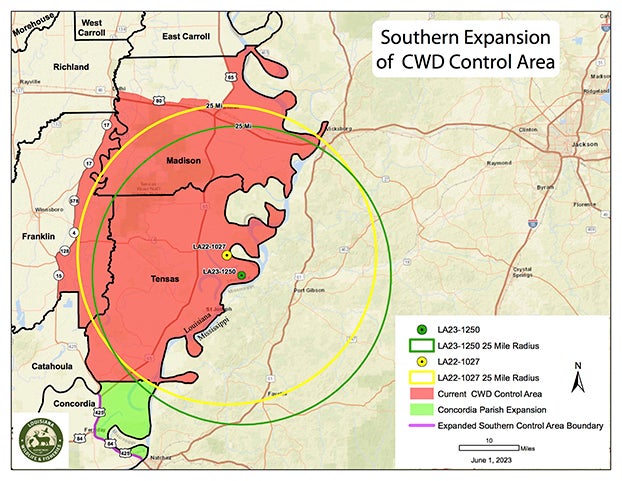Concordia Parish placed in Chronic Wasting Disease Control Zone
Published 3:27 pm Thursday, June 1, 2023

- This map shows the CWD zones for Louisiana and the radius used to place part of Concordia Parish in the CWD management zone. (Courtesy LDWF)
|
Getting your Trinity Audio player ready...
|
BATON ROUGE — Portions of Concordia Parish are now included in the Chronic Wasting Disease Control Zone due to its proximity to new positive detections of the 100 percent fatal infectious prion deer disease in Tensas Parish. The Louisiana Department of Wildlife and Fisheries Commission made the decision Thursday during their monthly commission meeting because of cases being found further south.
Areas of Concordia Parish north and east of US 425 and US84 are in the Chronic Wasting Disease Zone while portions to the west are not in the zone. A 25 mile radius from a positive detected in Tensas Parish placed the north portion of Concordia Parish in the zone. Louisiana has detected 12 CWD positive deer, all in Tensas Parish, since January of 2022. Tensas Parish and parts of Franklin and Madison Parishes were already included in the CWD Zone.
CWD Control Areas are part of the Louisiana Department of Wildlife and Fisheries (LDWF) response to CWD positive detections in deer harvested in Tensas Parish, the first of which came in January of 2022. CWD is a neurodegenerative disease of white-tailed deer and other members of the deer family. The disease is infectious, always fatal, and has no known treatment.
The disease can be transmitted from live deer, deer carcasses or other environmental sources such as plants or soil contaminated from exposure to CWD positive deer or deer carcasses. To learn more about CWD and complete regulations, go to: www.wlf.louisiana.gov/page/cwd
Here are a summary of CWD Control Area regulations:
- All supplemental feeding, including mineral or salt licks, is prohibited. The purpose of this feeding ban is to reduce the potential for the spread of CWD through artificial congregation of deer at bait sites.
- The use of approved bait not normally ingested by deer for feral hog trapping will be allowed.
- The export of cervids, cervid carcasses or parts of cervid carcasses originating within CWD Control Area is prohibited, except for: meat that is cut and wrapped; meat that has been boned out; quarters or other portions of meat with no part of the spinal column or head attached, antlers, clean skull plates with antlers, cleaned skulls without tissue attached, capes, tanned hides, finished taxidermy mounts and cleaned cervid teeth.
- Export exceptions for taxidermy, which require a permit, have been established. The deer head waiver permit must be completed before moving the deer head outside of the CWD Control Area to a taxidermy business. The permit is available on the LDWF CWD webpage (link above). Additional taxidermy waiver instructions on transport and disposal are available by visiting https://www.wlf.louisiana.gov/assets/Hunting/Deer/Files/Taxidermy-waiver-instructions-CWD-Control-Area.pdf
Spanning the river
Mississippi Department of Wildlife, Fisheries and Parks Commission opted to not place Claiborne County or Jefferson County in a Chronic Wasting Disease Management Zone despite scientific evidence from Mississippi State University’s Deer Lab showing deer swimming across the Mississippi River multiple times. There have been positives found in Tensas Parish, which were within two miles of Claiborne County on the east bank of the Mississippi River this past deer season.
MDWFP’s commission voted to include only the parts of Claiborne County on the west side of the navigational channel in the Mississippi River in a CWD control zone. Ed Penny, a private landowner in Claiborne County, asked the commission to reconsider their position to no avail in January.
Hunters, landowners and habitat managers in both states can help reduce the risk of spreading Chronic Wasting Disease by eliminating artificial congregation of deer by not using feeders, salt licks and mineral blocks. Well managed food plots are a great way to supplement a deer’s diet during stress periods in late summer and winter.
Proper habitat management by encouraging browse and forb production is another way to ensure deer have enough food and nutrients needed to grow bigger and better antlers or bodies. Nutrition is important to does as MSU research has shown a well fed doe will lead to growth in deer over generations.






